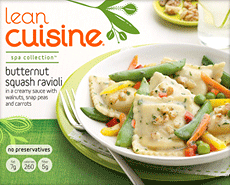I came across this little blurb in Glamor magazine this week at the hair salon. What a great encapsulation of the whole "green washing" phenomena that is sweeping America. Women, in particular, are susceptible to this with foods that portray themselves as healthier, lower in calories and more wholesome creating the misconception that they must also be "good for us." We are suckers for "green" beauty products, too. As the illustration above states, the only real way to know if a product truly IS green/organic/natural/etc. is to READ THE LABLE!
In pursing my local grocery store, I came across an example of green-washing in the snack isle:
The "smart" popcorn in the green package touts itself as being healthy and "94% fat free"and only 100 calories, but turning the package over and looking at the nutrition information label and ingredient list reveals a long list of ingredients and additives that have absolutely nothing to do with popcorn. The jar of popcorn below contains only one ingredient - popcorn kernels. That's it. AND it's considerably cheaper, by weight than the box of individual packets above. AND, there are no health claims, special packaging, or enticements on the label. It would be easy to pass this up, thinking that a "healthier" choice surely must be one like the package above, but, seriously, which one do you think really IS healthier?
We are bombarded with messages/claims on packaging and in advertising for foods and beauty products constantly. It can be difficult to sort out the facts from the hype. Think about the "Milk, it does a body good" campaign (that also includes the admonition to consume 3 servings of dairy a day to maintain "lean weight"). This is a great example of advertising that poses as educational. How can you become a more savvy shopper? Some great questions* to ask yourself when trying to determine if a product is really worth purchasing might include:
Who made this message?
Who is the target audience (and how do I know)?
Who might benefit from this message?
What is left out of this message that might be important to me?
Think about the package colors (greens, beige, off-white, brown), the graphics (produce, farms, "happy" looking animals, leaves, burlap-like textures), and the wording ("100%" ... but 100% of WHAT? "contains NATURAL/ORGANIC ingredients" does not mean the entire product is natural/organic, only that something in it is...).
Here are a few other examples of green washing:
*Questions from NAMLE's (National Association for Media Literacy Education) Core Principles of Media Literacy Education

















